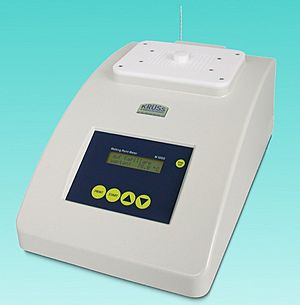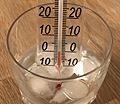Melting point facts for kids
The melting point is a special temperature. It's the exact temperature where a solid substance changes into a liquid. Think of an ice cube: when it gets warm enough, it turns into water. That exact temperature is its melting point. This usually happens at normal air pressure, like what we experience every day.
For water, this special temperature is 0 degrees Celsius (which is 32 degrees Fahrenheit or 273.15 Kelvin).
What is the Freezing Point?
Just like solids can melt into liquids, liquids can also turn back into solids. When a liquid substance becomes a solid, we call that its freezing point. For most substances, like water, the melting point and the freezing point are the same temperature. Water melts at 0°C and freezes at 0°C.
However, some substances are a bit different. They might melt at one temperature but freeze at a different one. For example, a substance called Agar melts at about 85°C, but it freezes at a much lower temperature, between 35°C and 40°C. Scientists call this interesting behavior hysteresis.
How Impurities Change Melting Points
The melting point of a substance can change if you add other things to it. These added substances are sometimes called "impurities." For instance, if you add sugar or salt to water, it will lower the water's freezing point. This is why people sometimes put salt on icy roads in winter – it makes the ice melt at a colder temperature.
On the other hand, adding alcohol to water can actually raise its melting point. This shows how different substances can affect each other's properties.
Images for kids
-
Ice cubes put in water will start to melt when they reach their melting point of 0 °C.
-
Melting points (in blue) and boiling points (in pink) of the first eight carboxylic acids (°C).
See also
 In Spanish: Punto de fusión para niños
In Spanish: Punto de fusión para niños






